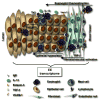Basic pathogenesis of eosinophilic esophagitis
- PMID: 18061107
- PMCID: PMC2194642
- DOI: 10.1016/j.giec.2007.09.016
Basic pathogenesis of eosinophilic esophagitis
Abstract
Eosinophilic esophagitis (EE) is a newly recognized disease, which has largely been called idiopathic EE, emphasizing the poor understanding of its pathogenesis. EE is a severe disease of the esophagus characterized by an accumulation of eosinophils in the esophageal mucosa, and is highly associated with atopic disease. Nevertheless, the nomenclature "eosinophilic esophagitis" describes only the tip of the iceberg of a complex disorder, as the pathogenesis of EE involves multiple tissues, cell types, and genes, and derives from complex genetic and environmental factors. This article defines the fundamental knowledge available to date that characterizes the mechanisms by which certain etiological factors cause EE, reviewing human studies, murine models, and recent knowledge regarding the involvement of environmental, cellular, molecular, and genetic factors in the development of EE.
Figures


Similar articles
-
Translational research on the pathogenesis of eosinophilic esophagitis.Gastrointest Endosc Clin N Am. 2008 Jan;18(1):145-56; x. doi: 10.1016/j.giec.2007.09.013. Gastrointest Endosc Clin N Am. 2008. PMID: 18061108 Review.
-
Eosinophilic esophagitis: pathogenesis, genetics, and therapy.J Allergy Clin Immunol. 2006 Nov;118(5):1054-9. doi: 10.1016/j.jaci.2006.07.038. Epub 2006 Sep 18. J Allergy Clin Immunol. 2006. PMID: 17088129 Review.
-
Epidemiology and etiology of eosinophilic esophagitis.Gastrointest Endosc Clin N Am. 2008 Jan;18(1):33-44; viii. doi: 10.1016/j.giec.2007.09.002. Gastrointest Endosc Clin N Am. 2008. PMID: 18061100 Review.
-
The natural history and complications of eosinophilic esophagitis.Gastrointest Endosc Clin N Am. 2008 Jan;18(1):99-118; ix. doi: 10.1016/j.giec.2007.09.009. Gastrointest Endosc Clin N Am. 2008. PMID: 18061105 Review.
-
Eosinophilic esophagitis: association with allergic disorders.Gastrointest Endosc Clin N Am. 2008 Jan;18(1):119-32; x. doi: 10.1016/j.giec.2007.09.001. Gastrointest Endosc Clin N Am. 2008. PMID: 18061106 Review.
Cited by
-
Eosinophilic esophagitis.Saudi Med J. 2023 Jul;44(7):640-646. doi: 10.15537/smj.2023.44.7.20220812. Saudi Med J. 2023. PMID: 37463709 Free PMC article. Review.
-
Epidemiology of food protein-induced enterocolitis syndrome.Curr Opin Allergy Clin Immunol. 2014 Jun;14(3):208-16. doi: 10.1097/ACI.0000000000000056. Curr Opin Allergy Clin Immunol. 2014. PMID: 24686277 Free PMC article. Review.
-
Pathophysiology of Eosinophilic Esophagitis.Clin Rev Allergy Immunol. 2018 Aug;55(1):19-42. doi: 10.1007/s12016-017-8665-9. Clin Rev Allergy Immunol. 2018. PMID: 29332138 Review.
-
Mechanisms of Disease of Eosinophilic Esophagitis.Annu Rev Pathol. 2016 May 23;11:365-93. doi: 10.1146/annurev-pathol-012615-044241. Epub 2016 Feb 24. Annu Rev Pathol. 2016. PMID: 26925500 Free PMC article. Review.
-
The Regulatory Function of Eosinophils.Microbiol Spectr. 2016 Oct;4(5):10.1128/microbiolspec.MCHD-0020-2015. doi: 10.1128/microbiolspec.MCHD-0020-2015. Microbiol Spectr. 2016. PMID: 27780017 Free PMC article. Review.
References
-
- Noel RJ, Putnam PE, Rothenberg ME. Eosinophilic esophagitis. N Engl J Med. 2004 Sep 26;351(9):940–941. - PubMed
-
- Garcia-Careaga M, Jr, Kerner JA., Jr Gastrointestinal manifestations of food allergies in pediatric patients. Nutr Clin Pract. 2005 Oct;20(5):526–535. - PubMed
-
- Spergel JM. Eosinophilic esophagitis in adults and children: evidence for a food allergy component in many patients. Curr Opin Allergy Clin Immunol. 2007 Jun;7(3):274–278. - PubMed
-
- Markowitz JE, Spergel JM, Ruchelli E, Liacouras CA. Elemental diet is an effective treatment for eosinophilic esophagitis in children and adolescents. Am J Gastroenterol. 2003 Apr;98(4):777–782. - PubMed
-
- Levy AM, Gleich GJ. Case 26-1996: hypersensitivity to carbamazepine. N Engl J Med. 1997 Jan 30;336(5):376. author reply 377. - PubMed
Publication types
MeSH terms
Substances
Grants and funding
LinkOut - more resources
Full Text Sources
Other Literature Sources
Medical

